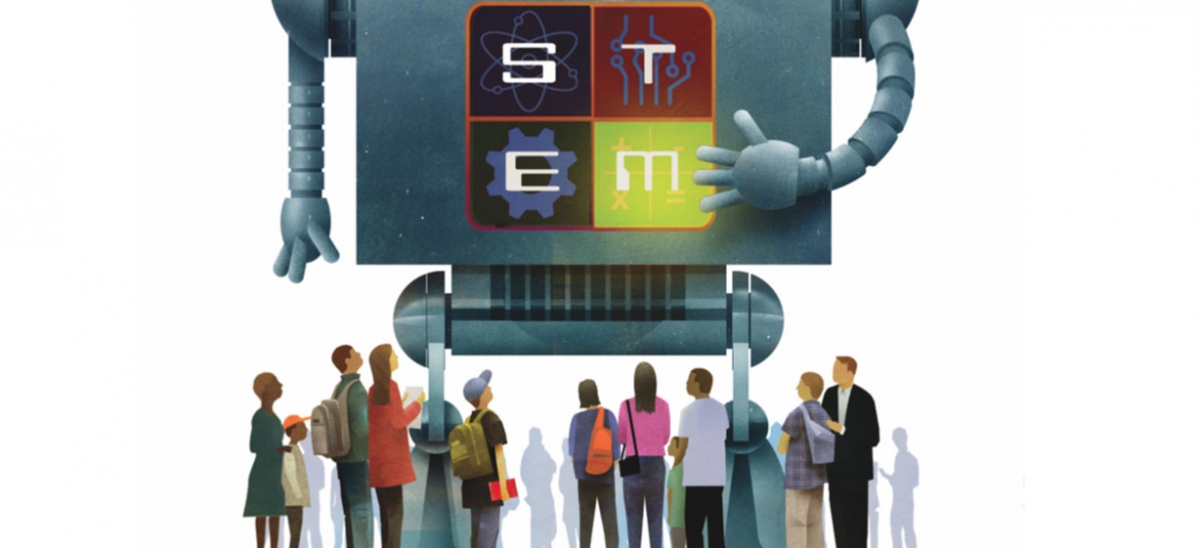Building STEM Solutions

Our region is facing a potentially crippling workforce shortage, with too few young, skilled workers to replace an older generation poised for retirement. According to research by the Allegheny Conference on Community Development, the gap could be yawning—as many as 144,000, with the STEM (science, technology, engineering, math) fields especially hard hit. No one expects the gap to reach those proportions, but the prospect of a regional economy sputtering for lack of workers has galvanized collaborative efforts to address the problem. This second installment of a series on the workforce gap examines some of the long-term efforts to change the ways STEM skills are taught and perceived.
You don’t have to tell Trip Oliver about the workforce gap. Every day, Oliver, manager of policy, government and public affairs for Chevron Corporation’s Appalachian/Michigan strategic business unit, can look at any of his company’s rigs in the region and wonder if and where the next generation of skilled workers might emerge.
“I don’t see it as much as a problem for us as it is down through the supply chain,” Oliver says. “If you go to any one of our drilling sites, 80 percent to 90 percent of the people on site are contractor employees.”
Chevron, one of the largest operators in the Marcellus shale formation, is spearheading a long-range approach to the problem by financing projects to fundamentally change STEM education. Not only is Chevron the title funder of the Chevron Center for STEM Education and Career Development at the Carnegie Science Center, but since 2011, it also has provided a total of $130 million for such initiatives as: Appalachia Partnership Initiative, a $20 million effort designed to address education and workforce development in 27 counties across southwestern Pennsylvania, northern West Virginia and eastern Ohio; Project Lead the Way, which is building STEM programs in area K-12 schools through curriculum resources, hands-on science learning and teacher training; ShaleNET, a workforce training program for the oil and natural gas industry; Development of Energy Labs at Elizabeth Forward and Bethlehem Center school districts, working in conjunction with graduate students at Carnegie Mellon University’s Entertainment Technology Center.
“Exposing young people to career options really has to be part of a STEM program.”
—Alana Kulesa, Director of Strategic Education Initiatives, Carnegie Science Center
“When we started talking about this with the Allegheny Conference several years ago, we were evaluating the biggest challenges this region faces and how Chevron could play a part in solving those problems,” Oliver says. “The skills gap kept coming up again and again. It’s obvious to us that people who are experts in this field believe this will be an impediment to regional economic growth in the future. That’s why Chevron stepped up. We sought to take a lead role and act as a catalyst to help bring others to the table.
“We’re focused on two key things: developing enhanced STEM education—especially for kids in middle school and high school—and developing good technical programs that will enable people in this region to compete for jobs. In the past, people viewed K-12 education and technical training as separate silos. We view them as a continuum of education.”
Oliver says Chevron also is sensitive to the concern that the shale industry is importing employees rather than recruiting and training local workers.
“Some critics say that all the jobs are going to people moving here from Texas, Oklahoma and Louisiana. It’s not as big an issue as some of our critics would have you believe. Nevertheless, one of the things that we as an industry are focused on is ensuring that jobs created here, to the extent possible, go to people already living here so people in the region can benefit.”
Initiatives targeted at rethinking STEM education and training are underway throughout the region. Most are promising; all will take time.
“It’s not something that will make drastic changes in outcome overnight,” Oliver cautions. “There has to be a commitment over an extended period of time to show measurable impact. You need staying power with this program.”
Changing the STEM education equation
The Carnegie Science Center’s Chevron STEM Center is also supported by: Bayer, Duquesne Light, Eaton, Kennametal Foundation, Nova Chemicals and the PPG Industries Foundation. It’s particularly active in long-term efforts to rethink how STEM skills are taught. Ideally positioned at the intersection of formal and informal education, it has the opportunity to be creative while maintaining credibility with school districts, teachers, students and parents.
Among the center’s programs is the Carnegie STEM Excellence Pathway, a suite of online tools, developed with support from the Heinz Endowments, that helps school districts assess their current STEM programs and begin to create enhanced approaches.
“We’re trying to change the equation around STEM education,” says Alana Kulesa, director of the Science Center’s strategic education initiatives. “It’s a continuous improvement process for schools around their STEM education programs. Some schools already are underway and have some amazing things happening. Others are saying, ‘We need to get on this bandwagon—how do we begin?’”
Assessments focus on six areas: teacher qualification, curriculum, instructional practices, assessment and demonstration of skills, family engagement and real-world connections. The latter two, Kulesa notes, often are overlooked.
“Traditional self-assessments look primarily at the academic side of things,” she says. “One thing about our program—we also include attention to family engagements and real-world connections. Exposing young people to career options really has to be part of a STEM program.”
Sixty-seven school districts, including districts in Kansas, Missouri and Vermont, have become “Pathway Partners.” Each has received a sort of grade ranging from “preemerging” to “leading,” although Kulesa stresses that the evaluation should be seen as a step in a continuous improvement process.
“Our hope moving forward is that we’ll be able to share some of the leading practices with other districts in the region,” she says. “Another thing we’re hoping is that the Carnegie Science Center will be seen more as a committed partner with schools rather than just a wonderful place for a field trip.”
Teachers as guides
What better way to introduce students to STEM careers than to invite them to interact with executives in those fields— and get hands on with the tools at the Carnegie Science Center? That’s the purpose of the center’s SciTech Days, which typically feature 40-50 corporate representatives. This year’s curriculum included sessions devoted to ELine design, Gamestar Mechanic, and designing and building video games.
The center offers companion sessions for teachers, and where classes can’t make it to the center—transportation can be a surprising obstacle—the center will go to them. Says Jason C. Brown, director of science and education:
“We have the benefits of being an informal science education environment. We have more opportunity than teachers do in that we’re content focused but not beholden to standardized testing. We can convey more inspirational-type activities they can utilize in their classrooms.
“When I was in high school, science class was all about lectures and teachers writing something on a board. Teachers today don’t want to do that. They want to be more of a guide, to use inquiry to help students learn on their own. We’re trying to facilitate that with them.”
Other science center projects underway include STEMisphere, an online directory that school districts, teachers and parents can use to find STEM resources—for instance, a summer program for young women—and a study spanning 17 counties in the region to determine what parents and business leaders consider the best directions for STEM education.
Robots: Sexy & interactive
Robots are not all about lectures and teachers writing on a board. They’re sexy, interactive… and a gateway to STEM careers. Since 2006, BotsIQ of Southwestern Pennsylvania has been using robots—specifically, robotics competitions among high schools—to introduce students to STEM skills and the employers who might mentor and hire them. Jeff Kelly, CEO of Hamill Manufacturing Company and then-president of the National Tooling and Machining Association, inspired the concept when he saw a similar Florida organization in action. To date, BotsIQ in this region has involved more than 4,000 students and over 100 companies.
“Kids are learning about the manufacturing process,” says Bill Padnos, the initiative’s executive director. “Some may design, some may do machining or electrical engineering, others are involved in documentation or fundraising. They learn there’s teamwork in the manufacturing process. One of our main goals is to show students the career pathways. We want to show them there are many ways you can pursue a manufacturing career.”
In the competition, teams of at least three students work on their robots in the classroom as well as after school. Thanks to a $150,000 grant from Chevron, BotsIQ is able to award stipends up to $1,050 to help finance projects. Winners—and any other participating teams, really—may advance to the national competition sponsored by the National Robotics League.
How is BotsIQ doing at preparing young candidates for post-secondary STEM training and jobs in those fields? Padnos estimates that about 20 percent of participants are female, an encouraging number, since women typically are seriously under-represented in STEM fields. In addition, the program is drawing entrants from a broad mix of institutions—urban, suburban and rural schools, those with limited resources and those more amply endowed. The 2013 winning regional team represented Clairton, a financially distressed school district, and was captained by two women.
Just as important, Padnos notes, the experience is not one-and-done for students. When BotsIQ surveyed its alumni last year, it found that 82 percent remained on STEM career pathways.
“The robotics competition really is a secondary component,” Padnos says, “because we truly are a manufacturing workforce development program. We’re trying to engage students so they will recognize, explore and consider manufacturing careers as a viable option…
“Bots gives manufacturers the opportunity to make direct connections to students and schools rather than sitting at a career fair and watching their candy supplies go down. Companies themselves need to take advantage of this opportunity. The only people who can change the perception of manufacturing are manufacturers.”




